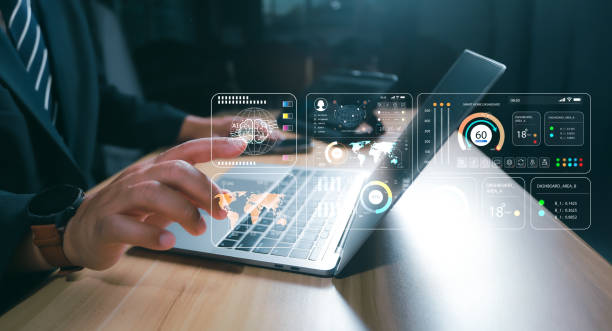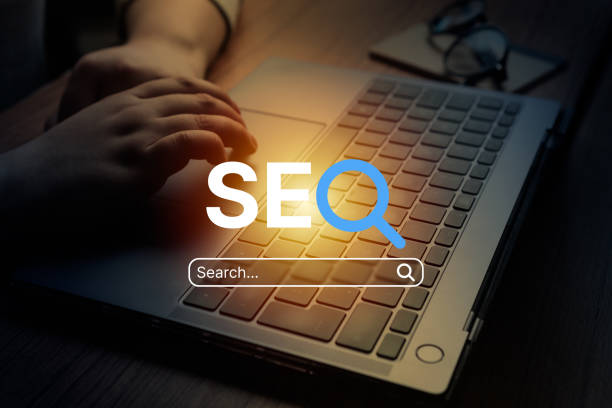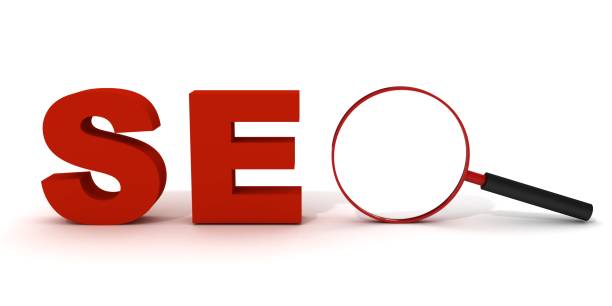What is On-Page SEO and Why Does it Matter?

On-Page SEO refers to a set of actions you take within your website to improve your ranking in search results.
These actions include optimizing content, site structure, HTML tags, and other related factors that you have direct control over on your website.
The importance of on-page SEO lies in the fact that it helps search engines better understand your website’s content and display it to the right audience.
By optimizing on-page SEO, you can attract more organic traffic and increase your conversion rate.
For example, using relevant keywords in titles, meta descriptions, and the main text of the page shows search engines what your page is about.
Also, improving site loading speed and creating a logical internal linking structure improves user experience and helps search engines better crawl your site’s pages.
More information about SEO.
On-page SEO, compared to Off-Page SEO, which includes actions outside of the website such as link building, gives you more control.
Therefore, by focusing on on-page SEO, you can create a strong foundation for success in search results and attract more targeted traffic.
In fact, on-page SEO is the first step towards having a successful website.
On-page SEO is considered an essential part of #Digital_Marketing and plays a crucial role in the visibility of your website in search engines.
Do you have an online store but your sales aren’t as expected? Rasaweb solves your problem forever with professional online store designs!
✅ Significant increase in conversion rate and sales
✅ Unparalleled user experience for your customers
⚡ Click to receive free consultation from Rasaweb!
Keyword Research; The Cornerstone of On-Page SEO

Keyword research is the first and most important step in on-page SEO.
Keywords are the phrases that users use to search for information in search engines.
By knowing the keywords related to your business, you can produce content that exactly meets the needs of your audience.
To start keyword research, you must first create a list of the main topics related to your business.
Then, using keyword research tools such as Ahrefs, SEMrush and Google Keyword Planner, find keywords related to each topic.
When choosing keywords, pay attention to search volume (the number of times the keyword is searched per month) and competition (how difficult it is to rank for the keyword).
Categorize keywords based on user intent.
Is the user looking for information (informational keywords), intending to buy (transactional keywords), or looking for a specific website (navigational keywords)? By understanding user intent, you can create content that best meets their needs.
Finally, use the selected keywords in your on-page SEO strategy.
Choosing appropriate and relevant keywords plays a vital role in the success of your site’s on-page SEO and helps you attract targeted traffic to your website.
Optimizing Page Title (Title Tag) and Meta Description

The Title Tag and Meta Description are two important HTML elements that are displayed in search results.
The Title Tag is the main title of your page that is displayed at the top of the browser and in search results.
The Meta Description is a short summary of the page content that is displayed below the page title in search results.
Optimizing the Title Tag and Meta Description is very important for on-page SEO, as these two elements are the first thing users see in search results.
An attractive and relevant Title Tag can encourage users to click on your link.
A concise and informative Meta Description can help users understand what your page is about and whether it meets their needs.
To optimize the Title Tag, use the main keyword of the page at the beginning of the title.
The title should be attractive, relevant, and a maximum of 60 characters.
To optimize the Meta Description, write a short and attractive summary of the page content.
The Meta Description should include the main keyword and related keywords and be a maximum of 160 characters.
By correctly optimizing the Title Tag and Meta Description, you can increase your click-through rate (CTR) in search results and attract more traffic to your website.
This is one of the most important factors in on-page SEO.
| Feature | Title Tag | Meta Description |
|---|---|---|
| Length | Maximum 60 characters | Maximum 160 characters |
| Content | Main keyword + Brand | Attractive summary of content + Keyword |
| Goal | Attract clicks and improve ranking | Inform and encourage clicks |
Optimizing Page URLs

URL (Uniform Resource Locator) is the address of a page on the web.
Optimizing page URLs is very important for on-page SEO, as URLs help search engines understand the topic of the page and show users what page they will be taken to when they click on the link.
An optimized URL should be short, descriptive, and include the main keyword of the page.
Avoid using uppercase letters, special characters, and meaningless numbers in your URL.
Instead of using spaces, use a hyphen (-) to separate words.
URLs should be readable and understandable so that users and search engines can easily understand the topic of the page.
For example, instead of using a URL like example.com/p=123, use a URL like example.com/seo-internal-optimization.
Organize the URL structure of your site logically and hierarchically.
This helps search engines better crawl your site’s pages and understand the connection between pages.
By optimizing page URLs, you can improve your ranking in search results and enhance user experience.
Using short and optimized URLs is an important on-page SEO technique.
Did you know that 94% of users’ first impressions of a business are related to its website design? With professional corporate website design by **Rasaweb**, turn this initial impression into an opportunity for growth.
✅ Attract more customers and increase sales
✅ Create credibility and trust in the eyes of the audience⚡ Get a free website design consultation!
Optimizing Page Content

Content is king! This sentence is often heard in the world of SEO and indicates the high importance of content in improving the site’s ranking in search results.
Optimizing page content for on-page SEO includes producing high-quality, relevant, and valuable content for users.
Your content should answer the questions and needs of the audience and encourage them to spend more time on your site.
To optimize page content, you must first do keyword research and find keywords related to the topic of the page.
Then, use the keywords naturally in the titles, subtitles, paragraphs, and images of the page.
Avoid creating duplicate content and try to produce unique and original content.
Update your content regularly and add new information to it.
Also, format your content for better readability using appropriate fonts, spacing, and attractive images.
Using lists, tables, and infographics can also help improve the readability and attractiveness of your content.
Optimizing content for search engines is only part of the job.
Your content must be valuable to users and meet their needs.
By producing high-quality and valuable content, you can attract more organic traffic to your website and increase your brand’s credibility.
This is a fundamental principle in on-page SEO.
Optimizing Images (Image Optimization)

Images play an important role in the visual appeal and improving the user experience of a website.
However, unoptimized images can slow down site loading speed and negatively impact on-page SEO.
Image optimization includes reducing file size, using appropriate formats, and adding Alt Text.
Before uploading images to the site, reduce their file size using image compression tools such as TinyPNG or ImageOptim.
Use optimized image formats such as JPEG for images with many colors and PNG for images with transparent backgrounds.
Alt Text is a short description of the image that helps search engines understand the topic of the image and is displayed to users if the image fails to load.
Use keywords related to the topic of the page in the Alt Text of the images.
In addition, optimize the file name of the images as well.
Instead of using default names like IMG_1234.jpg, use descriptive names that include keywords.
For example, instead of using IMG_1234.jpg, use seo-internal-optimization.jpg.
By optimizing images, you can improve site loading speed, enhance user experience, and increase your ranking in search results.
Image optimization is an essential step in the on-page SEO process.
Optimizing Internal Linking Structure (Internal Linking)

Internal Linking refers to the process of creating links between different pages of a website.
Internal linking helps search engines better crawl your site’s pages and understand the connection between pages.
Also, internal linking helps users easily navigate your site and find the information they need.
More information about internal linking.
An optimized internal linking structure should be logical and hierarchical.
Links should be created from important pages to less important pages and vice versa.
Use descriptive Anchor Text that is relevant to the destination page.
Avoid creating too many links on one page and try to place the links naturally in the text of the content.
Linking pages to each other increases the credibility of the site’s on-page SEO.
| Benefit | Description |
|---|---|
| Improve ranking | Increase the credibility of related pages |
| Improve user experience | Ease in finding information |
| Content discovery | Help search engines find pages |
By creating a strong internal linking structure, you can improve your ranking in search results, enhance user experience, and drive more traffic to important pages of your site.
Internal linking is one of the most important factors in on-page SEO and should be given special attention.
Optimizing Site Loading Speed (Page Speed)

Site loading speed (Page Speed) is one of the important ranking factors in Google.
Users expect web pages to load in a few seconds, otherwise, they may leave your site.
Slow site loading speed can increase the bounce rate and negatively impact on-page SEO.
To optimize site loading speed, you must first test your site’s speed using tools like Google PageSpeed Insights or GTmetrix.
Then, identify the speed-related problems and fix them.
Some of the ways to optimize site loading speed include compressing images, enabling browser caching, using CDN (Content Delivery Network), optimizing HTML, CSS, and JavaScript code, and using quality hosting.
Also, use an optimized template for your website to increase page loading speed.
By optimizing site loading speed, you can improve user experience, reduce bounce rate, and increase your ranking in search results.
High site loading speed indicates a professional and user-friendly website and plays an important role in the success of on-page SEO.
Are you frustrated with the low conversion rate of your online store?
Rasaweb is your definitive solution with professional online store design!
✅ Increase your sales and revenue
✅ Unparalleled user experience for your customers
⚡ Get a free consultation now!
Optimizing Site Responsiveness (Mobile-Friendly)

With the increasing use of mobile devices for browsing the internet, site responsiveness (Mobile-Friendly) has become one of the important ranking factors in Google.
A responsive site automatically adapts to the screen size of the user’s device (mobile phone, tablet, laptop) and provides a suitable user experience.
Google’s Mobile First Indexing.
To ensure your site is responsive, use a responsive template or design your site to be compatible with different devices.
Use fonts and images of appropriate size and avoid creating content that is difficult to view on mobile devices.
Google provides a tool called Mobile-Friendly Test that you can use to check the responsiveness of your site.
By optimizing site responsiveness, you can improve user experience, reduce bounce rate, and increase your ranking in search results.
Mobile optimization is a key pillar in the on-page SEO strategy and should not be neglected.
Using Schema Markup

Schema Markup is a type of code that helps search engines better understand your page’s content and display more accurate information in search results.
By using schema, you can provide information such as business name, address, phone number, business hours, user reviews, product prices, and events to search engines.
Using schema can increase your click-through rate (CTR) in search results and drive more traffic to your site.
Google supports various types of schema that you can find on the Schema.org site.
To add schema to your site, you can use SEO plugins like Yoast SEO or Rank Math or add the schema code manually to your site’s HTML code.
To check the validity of the schema code, you can use Google’s Rich Results Test tool.
By using schema, you can help search engines better understand your site’s content and display more accurate information in search results.
This can lead to increased organic traffic and improved site ranking in search results.
Using schema is an advanced strategy in on-page SEO that can have significant results.
Frequently Asked Questions
| Question | Answer |
|---|---|
| What is On-Page SEO? | It refers to a set of actions that are done within the website to improve the ranking in search engines. |
| Why is On-Page SEO important? | Because it helps search engines better understand the content and structure of your site and improves the user experience. |
| What are the most important elements of On-Page SEO? | Title and meta descriptions, keywords, URL structure, quality content, image optimization, internal linking, and site speed. |
| How to optimize the Title Tag and Meta Description? | The title should include the main keyword and be attractive, and the meta description should be a persuasive summary of the content with relevant keywords. |
| What is the role of keywords in On-Page SEO? | Keywords tell search engines what the content of the page is about and should be used naturally and intelligently in the text. |
| How is image optimization done for On-Page SEO? | By compressing the size, using descriptive file names, and filling the Alt tag with related descriptions and keywords. |
| What is Internal Linking and what is its use? | It is the connection of different pages of the site to each other. This helps to distribute the authority of the pages (Page Authority) and improve the crawling of search engines. |
| What is the importance of site loading speed in On-Page SEO? | High speed improves the user experience and is an important ranking factor for search engines like Google. |
| What effect does Mobile-Friendliness have on On-Page SEO? | Given the increase in mobile users, responsiveness is essential to provide a suitable user experience on all devices and is a priority for Google’s mobile index. |
| What are the important factors related to content in On-Page SEO? | Originality, quality, comprehensiveness, readability, proper use of headings (H1, H2,…) and regular content updates. |
And other services of Rasa Web advertising agency in the field of advertising
Smart customer journey map: A creative platform to improve online growth by optimizing key pages.
Smart reporting: A novel service to increase digital branding through proprietary programming.
Smart advertising campaign: Revolutionize customer acquisition by optimizing key pages.
Smart Conversion Rate Optimization: A novel service to increase click-through rates through Google Ads management.
Smart customer journey map: Designed for businesses looking to increase click-through rates through Google Ads management.
And more than a hundred other services in the field of internet advertising, advertising consulting and organizational solutions
Internet Advertising | Advertising Strategy | Report Advertising
Sources
What is internal SEO and on-page SEO?,How to become a successful SEO specialist?,Free SEO training,What is On-Page SEO?
? To reach the peak of success in the digital space, Rasa Web Digital Marketing Agency is with you. From user-friendly website design and SEO optimization to targeted advertising campaigns, we offer comprehensive solutions to grow your business.
📍 Tehran, Mirdamad Street, next to the Central Bank, Southern Kazerun Alley, Ramin Alley No. 6




